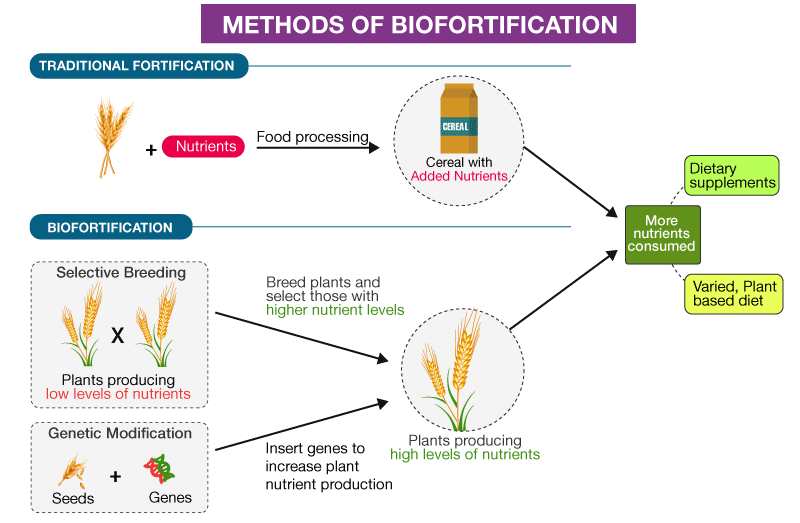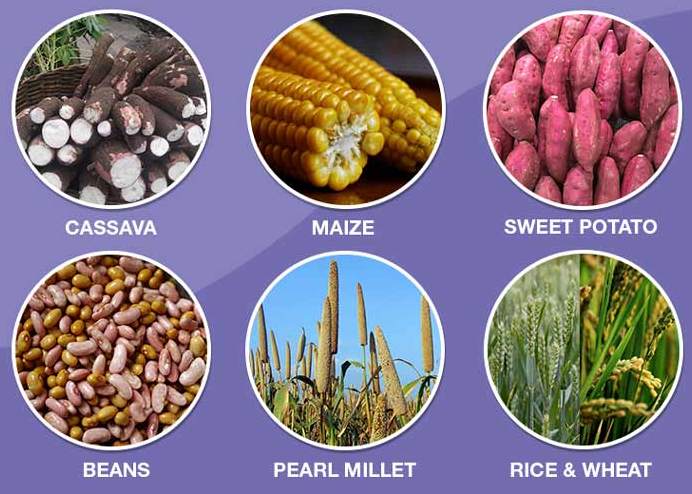फसल सुधार के माध्यम से जैव संवधर्न की भूमिका
Plants are the prime source of essential minerals nutrients. These mineral elements which play vital role for human beings for their existence and the continuity race of life. Some plants are rich for some mineral and have deficiency to the other. No plant alone that contain all mineral elements in efficiently for human beings from the earth.
Deficiency of mineral is also called as ‘Hidden hunger’, results in poor growth and compromised psychomotor development of children, reduced immunity, exhausted, fatigue, irritability, weakness, hair loss, wasting of muscles, sterility, morbidity and demise (Stein, 2010).
Conventional breeding and genetic engineering techniques are the two approaches that may be used to bio-fortify the crops with minerals like iron and zinc (Tiwari et al., 2010). “Biofortification” or “biological fortification” called as nutritionally enhanced food crops with increased bioavailability to the human population that are developed and grown using modern biotechnology tools, conventional plant breeding methods, and agronomic practices.
Biofortification is an upcoming, effective, bright, cost-effective, and sustainable technique of providing micronutrients to a population that has limited access to diverse diets and other micronutrient interventions. Success stories of biofortification include lysine and tryptophan rich QPM (quality protein maize), Vitamin A rich orange sweet potato; generated by crop breeding, oleic acid, and stearidonic acid soybean enrichment; through genetic transformation and selenium, iodine, and zinc supplementation.
The biofortified food crops which are cereals, legumes, vegetables, and fruits, are providing sufficient levels of micronutrients to targeted populations. Of micro elements, iron and zinc mineral deficiency are the most common and widespread, afflicting more than half of the human population in world (White and Broadley, 2009).
Table 1. Essential micro- and macronutrients required for human health
|
Micro-nutrients |
Macro-nutrients |
|||
|
Micro minerals |
vitamins |
Amino acids (essential) |
Fatty acids (essential) |
Macro-minerals |
|
Fe |
A (Retinol) |
Histidine |
Linoleic acid |
K |
|
Zn |
D (Calciferol) |
Isoleucine |
Linolenic acid |
Ca |
|
Cu |
E(α-Tocopherol) |
Leucine |
|
Mg |
|
Mn |
K (Phylloquinone) |
Lysine |
|
S |
|
I |
C (Ascorbic acid) |
Methionine |
|
P |
|
Se |
B1 (Thiamin) |
Phenylalanine |
|
Na |
|
Mo |
B2 (Riboflavin) |
Threonine |
|
Cl |
|
Co |
B3 (Niacin) |
Tryptophan |
|
|
|
Ni |
B5 (Pantothenic acid) |
Valine |
|
|
|
|
B6 (Pyridoxine) |
|
|
|
|
|
B7 (Biotin) |
|
|
|
|
|
B9(Folicacid, folacin) |
|
|
|
|
|
B2 (Cobalamin) |
|
|
|

The methodology of biofortification involves two principal methods:
1. Selective breeding :
This is the conventional breeding method which requires crops which have naturally occurring high nutritious value -to be crossbred with high-yielding varieties.
The development of the hybrid varieties must be monitored by nutritionists to check whether the improved levels of nutrients can be used by the consumers and how these levels are affected by storage, processing, and cooking of the food crop.
2. Genetic modification :
Change the genetic makeup of a domesticated crop by incorporating genes from the wild crop of same species or other species that code for the increased production of certain nutrients could make the host crop rich in nutrients.
One of the most glorious examples is that of golden rice which has been enriched with beta-carotene, a precursor of Vitamin A.
 List of staple crop in which biofortification applied
List of staple crop in which biofortification applied
Wheat Breeding:
Wheat as a staple crop is the first and foremost target for biofortification. Wide variation in grain iron and zinc concentrations in wheat and its closely related wild species has been observed that it can be exploited for improvement of modern elite cultivars.
The variety GJW 463 from JAU, Gujarat is recommended micronutrients Fe, Zn, Mn and Cu content of 31.9, 23.8, 22.4 and5.9 ppm, respectively with good chapatti making quality.
Six varieties of high zinc wheat (BHU 1, BHU 3, BHU 5, BHU 6, BHU 7, and BHU 18) were released in India in 2014.Two varieties BHU 1 and BHU 6 have high yield, disease resistance in addition to high zinc. Recently, variety with high zinc (PBW1Zn) has been released by PAU, India. Another variety with high zinc and iron content (WB2) has been developed and released by Indian Institute of Wheat and Barley Research, India.
Apart from releasing cultivars, several researchers have reported an increase in the zinc and iron content of wheat by plant breeding. Provitamin A has been another important nutrient targeted for biofortification through breeding. High provitamin A durum wheat variety (HI 8627) has been released by IARI, India in 2005.
Rice Breeding:
The natural variation of iron in rice is quite low and milling and polishing usually results in a loss of up to 80% since iron is mainly stored in the aleurone layer and not in the endosperm (Brinch-Pedersen et al., 2007).
Iron and zinc concentrations in rice of different genotypes (n= 1138) were found to range between 6.3- 24.4 μg/ g and 13.5- 58.4 μg/ g, respectively, suggesting that there is at least some genetic potential to successfully breed high mineral rice.
Maize Breeding:
Significant achievement in the field of maize biofortification is quality protein maize Vivek QPM-9 with high essential amino acids lysine and tryptophan by incorporating opaque-2 (o2) mutant gene from naturally occurring maize into the maize cultivars.
Other examples are Shakti, Rattan and Protina which have Soft endosperm, then Shakti-1, Shaktiman-1,2,3,4,5 and HQPM-1,2,3,4,5 which have Hard endosperm/QPM means have more endosperm lysine and tryptophan.
Pearl Millet Breeding:
Pearl millet is the cheapest source of iron and zinc and large variation has been seen in its germplasm for these micronutrients. GHB -1255 variety developed at JAU, Jamnagar which have ample zinc and iron proportion.In India, biofortified (iron and zinc) pearl millet variety “Dhanashakti” and a hybrid ICMH 1201 (Shakti-1201) has been released by ICRISAT, Harvest Plus in 2014.
Sorghum Breeding:
The prospects of breeding for micronutrients and beta-carotene rich sorghums have been discussed by Reddy et al. 2005. Sorghum varieties have been screened for high minerals, protein, lutein, zeaxanthin, and beta-carotene contents. Sorghum germplasm has shown large variability and genetic heritability for iron and zinc content.
Potato Breeding:
Potato tubers are the richest sources of antioxidants in human diet. Kufri series of potato have high zinc and iron. The natural variation of cultivated potato germplasm containing red and purple pigment could possibly represent the contribution of the potatoes to the portion of antioxidants in human nutrition.
Therefore, effort of breeders focuses on the breeding of such variants. Furthermore, vast genetic variation for micronutrients exists in potato that can be exploited for breeding to further increase iron and zinc levels in human diets.
Tomato Breeding:
Tomato is a highly valuable crop and an important source of vitamin A and C. Genetically diverse wild population of tomato has been investigated intensively for specific traits and exploited in tomato breeding.
Anthocyanin biofortified tomato “Sun Black” with deep purple fruit pigmentation due to high anthocyanin content in the peel has been developed by conventional breeding technique .
Limitations in conventional breeding methods:
With respect to the amount of genetic diversity for the micronutrients in the plant germplasm and the time needed to generate cultivars with the desired trait(s).
This can be overcome by crossing to distant relatives and thus introgression traits into commercial cultivars, but in many occasions, it would be impossible to breed for a specific trait using conventional means, and the timescale and effort involved may be quite unrealistic.
Conclusion:
Overall, nutrient biofortification of cereal grains by plant breeding and genetic engineering should be judicious of potential perturbations of the plant metabolic network. Bio-fortification of crops is a possible and most economical approach for resolving ‘hidden hunger’.
A dimensional effort strategy will play a vital role in overcoming hidden hunger. Our government put focus on development of nutrient more variety in all research station. For collaboration between plant breeders, nutrition scientists, genetic engineers, and molecular biologists are necessary.
Traditional breeding techniques are finding widespread and easy acceptance and have been used to increase the nutritional qualities of foods. Biofortified crops hold a very bright future as these have the ability to abstain micronutrient malnutrition among billions of poor people across the world, especially in the developing countries like India and Africa.
REFERENCES:
- Brinch PH, Borg S, Tauris and B, Holm PB. 2007. Molecular genetics approaches to increasing mineral availability and vitamin content of cereals. Journal of Cereal Science 46: 308-326.
- Reddy MS, Chen F, Shadle G, Jackson L, Aljoe H, Dixon R. A. 2005. Targeted down-regulation of cytochrome P450 enzymes for forage quality improve-ment in alfalfa (Medicago sativa L.). Proc Natl Acad Sci U S A. 102:16573–8. doi:10.1073/pnas.0505749102
- Stein A. J. 2010: Global impacts of human malnutrition. Plant Soil 335, 133-154.
- Tiwari, V. K., N. Rawat, K. Neelam, S. Kumar, G. S. Randhawa, and H. S. Dhaliwal. 2010. Substitution of 2S and 7U chromosomes of Aegilops kotschyi in wheat enhances grain iron and zinc concentration. Theor. Appl. Genet. 121, 259-269.
- White P. J., and MR. Broadley, 2009: Bio-fortification of crops with seven mineral elements often lacking in human diets iron, zinc, copper, calcium, magnesium, selenium and iodine. New Phytol. 182, 49- 84.
Authors
Dr.S. Parmar
Assistant Professor & Head,
Deptt. of Genetics & Plant Breeding, Collage of Agriculture,
Junagadh Agriculture University, Motabhandariya –Amreli (365610)
Email :
